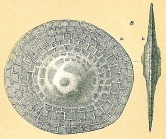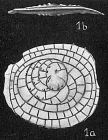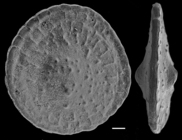
Chinese
Register of
Marine Species
(ChaRMS)
Register of
Marine Species
(ChaRMS)
| Intro | | Search taxa | | Taxon tree | | Sources | | Statistics | | Editors | | Log in |
WoRMS taxon detailsCycloclypeus W.B. Carpenter, 1856
484792 (urn:lsid:marinespecies.org:taxname:484792)
accepted
Genus
Cycloclypeus carpenteri Brady, 1881 (type by subsequent designation)
Cycloclypeus (Cycloclypeus) W.B. Carpenter, 1856 · alternative representation
Cycloclypeus (Katacycloclypeus) Tan, 1932 † · unaccepted (Opinion of Loeblich & Tappan, 1987)
Heteroclypeus Schubert, 1906 · unaccepted (Subjective junior synonym Opinion...)
Subjective junior synonym Opinion of Loeblich & Tappan, 1987
marine,
recent + fossil
masculine
Carpenter, W. B., 1856, Researches in the foraminifera. Pt. II. On the genera Orbiculina, Alveolina, Cycloclypeus and Heterostegina, Philosophical Transactions of the Royal Society 146:547-569.
page(s): p. 555 [details]
Hayward, B.W.; Le Coze, F.; Vachard, D.; Gross, O. (2025). World Foraminifera Database. Cycloclypeus W.B. Carpenter, 1856. Accessed through: World Register of Marine Species at: https://www.marinespecies.org/aphia.php?p=taxdetails&id=484792 on 2025-05-07
Date action by
Nomenclatureoriginal description
Carpenter, W. B., 1856, Researches in the foraminifera. Pt. II. On the genera Orbiculina, Alveolina, Cycloclypeus and Heterostegina, Philosophical Transactions of the Royal Society 146:547-569. page(s): p. 555 [details] original description (of Heteroclypeus Schubert, 1906) Schubert, R. J. (1906). <i>Heteroclypeus</i>, eine Uebergangsform zwischen <i>Heterostegina</i> und <i>Cycloclypeus</i>. <em>Centralblatt für Mineralogie, Geologie und Paläontologie.</em> 1906: 640-641., available online at https://biodiversitylibrary.org/page/49055554 page(s): p. 640 [details] original description (of Cycloclypeus (Katacycloclypeus) Tan, 1932 †) Tan, S. H. (1932). On the genus Cycloclypeus Carpenter, Part 1 and an appendix on the Heterostegines of Tjimanggoe, S. Bantam, Java. <em>Dienst van de Mijnbouw in Nederlandsch Indië, Wetenschappelijke mededeelingen.</em> 19: 1-194. [details] Otheradditional source
Loeblich, A. R.; Tappan, H. (1987). Foraminiferal Genera and their Classification. Van Nostrand Reinhold Company, New York. 970pp., available online at https://books.google.pt/books?id=n_BqCQAAQBAJ [details] Available for editors
From editor or global species database
Diagnosis Test large, circular in plan, centrally umbonate and narrowed at the periphery, microspheric test up to nearly 6 cm in diameter, megalospheric test up to 14 mm across, young microspheric form planispiral and evolute, megalospheric one with globular proloculus and reniform deuteroloculus followed by a few undivided nepionic chambers, then planispiral and peneropliform and finally with annular chambers subdivided into numerous chamberlets, those of successive cyclic chambers not aligned, chamberlets of microspheric and postnepionic megalospheric chambers formed by radial folds of the septal flap, the resultant double-walled secondary septa enclosing intraseptal canals in the interlocular space, X-or Y-shaped stolons lie in the median plane where the fold of the septal flap touches the inner apertural wall, a thin horizontal lamella in the median plane separates the stolons and results in a double foraminal aperture on the distal side of the septum, many vertically superimposed stolons also may occur around large megalospheric embryos, sutural canals simple and vertical as in Heterostegina, marginal cord present in the early spiral part of the test but disappears with the first annular chamber, canal system modified in the annular chambers to conform to the circular septa, sutural canals simple and unbranched; wall calcareous, hyaline, finely perforate, surface ornamented with raised annuli or may have concentric rings of pustules. L. Oligocene to Holocene; tropical Indo-Pacific. (Loeblich & Tappan, 1987, Foraminiferal Genera and Their Classification) [details]
|



